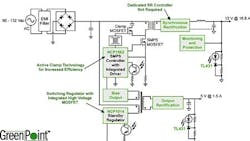New Discretes, Passives and Modules Shine at APEC
At APEC2007, several vendors displayed their latest offerings of passive components, discrete power semiconductors, and various dc-dc converter modules. These products reveal the innovation that continues in the mature industry of power electronics. They also reveal a focus on improved efficiency and power management shaped by international energy-usage regulations.
Vishay Intertechnology displayed three n-channel power MOSFETs for OR-ing applications. They feature 20-V drain-to-source and gate-to-source voltage ratings. These devices use TrenchFET Gen II technology. The Si4398DY delivers an RDS(ON) rating of 2.8 mΩ at 10 V. With a maximum RDS(ON) rating of 2.4 mΩ at 10 V, the Si7866ADP combines low conduction losses with robust thermal performance. The previously released SiE808DF maximum RDS(ON) rating is 1.5 mΩ at 10 V.
Another vendor, Toshiba, introduced its own high-speed switching MOSFETs using the UMOS-V process. This process improves many of the key parameters required for better power efficiency in both the high- and low-side MOSFETs in a synchronous dc-dc converter. The lineup includes eleven initial members rated for 30 V, with RDS(ON) values ranging from 3.1 mΩ to 11 mΩ. Additional UMOS-V MOSFETs are planned with higher voltage ratings, as well as p-channel, dual-channel and MOSBD (a MOSFET with a Schottky barrier diode).
Also suitable for dc-dc converters is a series of optical isolators that was introduced at APEC. The OPI1270, OPI1280 and OPI1290 from Optek consist of a visible red LED with phototransistor or Photologic sensor, and transfer data through a plastic flexible cable. This allows each end of the isolator to be mounted at different locations within the system. The isolators feature an isolation voltage of more than 20 kV with 0.05-in. (1.27-mm) lead spacing. The power dissipation rating is 100 mW.
Shifting to passives, two TT Electronics’ companies showed developments in the area of magnetics. MMG displayed high stability manganese-zinc ferrite core materials, designated F58 and P11. The F58 material features a frequency range of 200 kHz to 1 MHz and an initial permeability of 750 when measured at 10 kHz and 0.1 mT (25ºC). With a frequency range from 10 kHz to 500 kHz, the P11 material features an initial permeability of 2250 when measured at 10 kHz and 0.1 mT (25ºC). The F58 and P11 ferrite materials are available in standard RM and pot core geometries, while the F58 material is also available in toroidal core configuration.
TT electronics’ BI Technologies Magnetic Components Division introduced the HM56 Series, a cube inductor with a saturation current of 60 A. Suitable for high-frequency applications, the series features inductance values from 0.22 mH to 2.00 mH, with DCR values from 0.60 mΩ to 2.05 mΩ.
BI Technologies also introduced a dc-dc converter at APEC2007. Designated the Model MS2378, the 2-W converter is packaged in a hybrid SIP configuration and uses a ceramic base and hybrid technology to virtually eliminate any heat sinking requirements. The converter features a fixed output voltage of 5 V (3.3 V available) at up to 400 mA, and an input voltage range of 12 Vdc to 32 Vdc. Line regulation is 1.0% (measured at 16 V to 32 V at 400 mA) with load regulation of 1.0% (at 100 mA to 400 mA).
Another vendor, C&D Technologies, introduced two compact point-of-load converters that deliver 88% efficiency and 50-A/in3 current density for VRM solutions to power DDR1, DDR2 and DDR3 memory, as well as general-purpose ICs. Operating from a 12-V input, the 60-A VCN60BADJTU-1C and 70-A VCN70BADJTU-1C modules produce a programmable 0.6-V to 3.5-V output. The 60-A module measures 61 mm x 9.5 mm x 31.8 mm, while the 70-A module measures 61 mm x 16.8 mm x 31.8 mm.
Maintaining a similar focus on high efficiency, ON Semiconductor introduced its GreenPoint reference design (see figure) for 200-W power adapters intended for use in gaming consoles. The design can also be modified to include power factor correction. Targeting active-mode energy efficiency of 90% at full load, this soon-to-be qualified GreenPoint design achieves standby-mode power consumption of less than 1 W, exceeding CEC, ENERGY STAR, and European Code of Conduct requirements. A typical 200-W adapter used to power today’s game consoles consumes over 3 W in standby mode.
